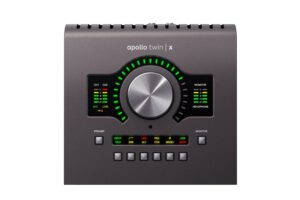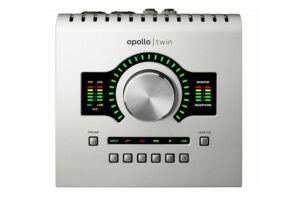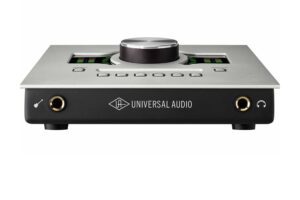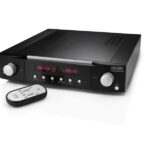The Apollo Twin and Apollo Twin X are two highly regarded audio interfaces from Universal Audio, renowned for their exceptional sound quality and robust performance.

This blog post will comprehensively compare these two models, exploring their design, audio quality, connectivity options, DSP processing power, software compatibility, and overall value.
By examining the features and specifications of the Apollo Twin and Apollo Twin X, we aim to provide musicians, producers, and audio enthusiasts with valuable insights to help them make informed decisions when choosing the ideal audio interface for their needs.
Contents
Design and Build Quality
The Apollo Twin and Apollo Twin X both boast sleek and professional designs, reflecting Universal Audio’s commitment to aesthetics and durability.
The Apollo Twin features a compact and portable form factor, making it ideal for on-the-go recording and production setups.
On the other hand, the Apollo Twin X offers a larger chassis with enhanced cooling capabilities, allowing for extended sessions without compromising performance.
Regarding build quality, both interfaces exhibit sturdy construction, utilizing high-quality materials that ensure long-lasting reliability.
The front panels of both models feature intuitive controls, including gain knobs and monitoring options, providing convenient access to essential functions.
Whether you prioritize portability or enhanced cooling, both the Apollo Twin and Apollo Twin X excel in design and build quality, catering to different user preferences.
Audio Quality and Conversion
The Apollo Twin and Apollo Twin X excel in delivering exceptional audio quality and precise conversion capabilities, ensuring pristine recordings and playback.
Both interfaces feature top-tier microphone preamps that capture the nuances of the sound source with remarkable clarity and accuracy.
The Apollo Twin is equipped with Unison preamps, which emulate the characteristics of classic analog preamps, allowing users to achieve authentic vintage tones.
In terms of sample rates, both interfaces offer impressive capabilities.
The Apollo Twin supports sample rates up to 192 kHz, while the Apollo Twin X takes it a step further with support for sample rates up to 24-bit/192 kHz, providing high-resolution audio for demanding projects.
The increased bit depth and dynamic range of the Apollo Twin X contribute to wider frequency response and greater detail in recordings.
Furthermore, the Apollo Twin X introduces advancements in audio fidelity, utilizing upgraded converters that offer improved signal-to-noise ratio and lower distortion.
These enhancements result in more accurate and transparent audio reproduction, capturing the subtleties of the original sound source with precision.
Whether you choose the Apollo Twin or Apollo Twin X, rest assured that both interfaces prioritize delivering exceptional audio quality and offer advancements in terms of preamp characteristics, sample rates, bit depths, and dynamic ranges.
Connectivity and I/O Options
Regarding connectivity and I/O options, the Apollo Twin and Apollo Twin X offer versatile configurations to accommodate a wide range of recording and production needs.
Both interfaces feature a combination of analog inputs and outputs. The Apollo Twin typically offers two analog inputs (mic/line) and four analog outputs (line).
Additionally, it includes a dedicated headphone output for monitoring purposes.
On the other hand, the Apollo Twin X provides increased flexibility with four analog inputs (mic/line) and six analog outputs (line), allowing for more extensive routing and connectivity possibilities.
In terms of digital connectivity, both interfaces support ADAT and S/PDIF formats, enabling users to expand their I/O capabilities by connecting external devices such as digital mixers or additional preamps.
However, the Apollo Twin X offers an advantage with its dual ADAT ports, doubling the potential input and output channels when compared to the Apollo Twin.
Furthermore, the Apollo Twin X introduces advancements in connectivity features.
It includes a dedicated monitor output, providing a separate control room output for seamless integration with studio monitoring systems.
This feature enhances the versatility and convenience of the interface, particularly for users with professional studio setups.
Whether you opt for the Apollo Twin or Apollo Twin X, both interfaces offer a range of analog and digital connectivity options.
However, the Apollo Twin X provides additional analog I/O channels and a dedicated monitor output, offering greater flexibility and compatibility with various recording and monitoring setups.
DSP Processing Power

The Apollo Twin and Apollo Twin X are equipped with powerful onboard DSP (Digital Signal Processing) that enables real-time processing and integration of Universal Audio’s renowned UAD plug-ins.
The DSP processing capabilities of these interfaces allow users to run complex audio effects and virtual instruments without taxing the computer’s CPU.
The number of available UAD plug-ins varies depending on the specific model.
The Apollo Twin typically offers a generous selection of UAD plug-ins, including iconic emulations of vintage analog gear, compressors, EQs, and reverbs.
Similarly, the Apollo Twin X provides access to a vast library of UAD plug-ins, allowing users to expand their sonic palette with a wide range of high-quality effects and processors.
The Apollo Twin X takes the lead in processing power and performance.
It features an upgraded DSP chip, offering double the processing power compared to the Apollo Twin.
This increased processing power enables users to run more demanding plug-in chains and achieve more intricate mixes.
Latency is an essential consideration for real-time processing.
Both interfaces deliver low-latency performance, allowing for seamless monitoring and recording experiences.
However, the Apollo Twin X may offer slightly improved latency performance due to its enhanced DSP capabilities.
Software and Compatibility
Both the Apollo Twin and Apollo Twin X are compatible with Universal Audio’s comprehensive software ecosystem, including the UA Console application and the UAD Powered Plug-Ins platform.
These software components provide intuitive control over the interfaces’ settings, routing, and DSP processing.
Both interfaces are compatible with popular digital audio workstations (DAWs) such as Pro Tools, Logic Pro, Cubase, and Ableton Live, ensuring seamless integration into various production workflows.
They are also compatible with both Mac and Windows operating systems.
Universal Audio often includes bundled software with their interfaces, and while the specific offerings may vary, users can expect to receive a collection of UAD plug-ins as part of the package.
These plug-ins add value and expand the creative possibilities for users right out of the box.
Additionally, the Apollo Twin X may benefit from software updates and improvements specific to its model.
These updates can include new features, enhanced performance, and added compatibility with the latest operating systems and DAW versions.
Users should stay informed about the latest software updates from Universal Audio to optimize their experience with the Apollo Twin X.
Pricing and Value
When comparing the price points of the Apollo Twin and Apollo Twin X, it’s important to note that the Apollo Twin X is typically priced higher than the Apollo Twin.
The price difference can be attributed to the enhanced features, increased I/O options, and improved Apollo Twin X processing power.
In terms of value, both interfaces offer exceptional quality and performance.
The Apollo Twin provides a solid entry point into the Universal Audio ecosystem, offering excellent audio fidelity, DSP processing capabilities, and compatibility with UAD plug-ins.

It is a suitable choice for those who require a portable and versatile interface at a more affordable price point.
On the other hand, the Apollo Twin X offers advanced features, including additional analog I/O channels, dual ADAT ports, and increased DSP processing power.
These enhancements make it a compelling option for professionals and users with larger studio setups who require greater connectivity and processing capabilities.
When considering value, factors such as warranty and customer support should be taken into account.
Universal Audio is known for its reliable products and provides warranty coverage for its interfaces.
Additionally, their customer support team is known for being responsive and knowledgeable, which contributes to the overall value and user experience.
Conclusion
The comparison between the Apollo Twin and Apollo Twin X reveals two exceptional audio interfaces that cater to different user needs and budgets.
Whether you prioritize portability and affordability or advanced connectivity and processing power, Universal Audio has you covered.
Both interfaces deliver outstanding audio quality, DSP processing capabilities, and compatibility with UAD plug-ins.
By carefully assessing your specific requirements and budget, you can make an informed decision that aligns with your creative goals.
Explore further resources, user reviews, and consult Universal Audio’s website for detailed specifications and information.
You can elevate your audio production with the Apollo Twin or Apollo Twin X.






